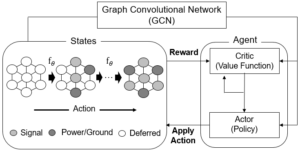Variational Quantum Approximate Support Vector Machine with Inference Transfer
Abstract
A kernel-based quantum classifier is the most practical and influential quantum machine learning technique for the hyper-linear classification of complex data. We propose a Variational Quantum Approximate Support Vector Machine (VQASVM) algorithm that demonstrates empirical sub-quadratic run-time complexity with quantum operations feasible even in NISQ computers. We experimented our algorithm with toy example dataset on cloud-based NISQ machines as a proof of concept. We also numerically investigated its performance on the standard Iris flower and MNIST datasets to confirm the practicality and scalability.
Main figure
Title: Sample-efficient inverse design of freeform nanophotonic devices with physics-informed reinforcement learning
Abstract:
Finding an optimal device structure in the vast combinatorial design space of freeform nanophotonic design has been an enormous challenge. In this study, we propose physics-informed reinforcement learning (PIRL) that combines the adjoint-based method with reinforcement learning to improve the sample efficiency by an order of magnitude compared to conventional reinforcement learning and overcome the issue of local minima. To illustrate these advantages of PIRL over other conventional optimization algorithms, we design a family of one-dimensional metasurface beam deflectors using PIRL, exceeding most reported records. We also explore the transfer learning capability of PIRL that further improves sample efficiency and demonstrate how the minimum feature size of the design can be enforced in PIRL through reward engineering. With its high sample efficiency, robustness, and ability to seamlessly incorporate practical device design constraints, our method offers a promising approach to highly combinatorial freeform device optimization in various physical domains.
Main figure:
Journal Name: ACS Photonics (IF 7.529)
Authors : Dongjin Seo, Daniel Wontae Nam, Juho Park, Chan Y. Park, and Min Seok Jang*
Title: Structural Optimization of a One-Dimensional Freeform Metagrating Deflector via Deep Reinforcement Learning
Abstract: The increasing demand on a versatile high-performance metasurface requires a freeform design method that can handle a huge design space, which is many orders f agnitude larger than that of conventional fixed-shape optical structures. In this work, we formulate the designing process of one-dimensional freeform Si metasurface beam deflectors as a reinforcement learning problem to find their optimal structures consistently without requiring any prior metasurface data. During training, a deep Q-network-based agent stochastically explores the device design space around the learned trajectory optimized for deflection efficiency. The devices discovered by the agents show over all improvements in maximum efficiency compared to the ones that state of-the-art baseline methods find at various wavelengths and deflection angles. Furthermore, the efficiencies of the devices generated by agents trained from different neural network initializations have a small variance, demonstrating the robustness of the proposed design method.
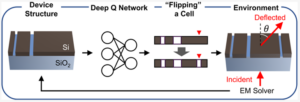
Journal Name: Review Article, Nanophotonics (IF 8.449)
Authors : Juho Park, Sanmun Kim, Daniel Wontae Nam, Haejun Chung*, Chan Y. Park* and Min Seok Jang*
Title: Free-form optimization of nanophotonic devices: from classical methods to deep learning
Abstract: Nanophotonic devices have enabled microscopic control of light with an unprecedented spatial resolution by employing subwavelength optical elements that can strongly interact with incident waves. However, to date, most nanophotonic devices have been designed based on fixed-shape optical elements, and a large portion of their design potential has remained unexplored. It is only recently that free-form design schemes have been spotlighted in nanophotonics, offering routes to make a break from conventional design constraints and utilize the full design potential. In this review, we systematically overview the nascent yet rapidly growing field of free-form nanophotonic device design. We attempt to define the term “free-form” in the context of photonic device design, and survey different strategies for free-form optimization of nanophotonic devices spanning from classical methods, adjoint-based methods, to contemporary machine-learning-based approaches.

Journal Name: Nanophotonics (IF 8.449)
Authors : Sanmun Kim, Jeong Min Shin, Jaeho Lee, Chanhyung Park, Songju Lee, Juho Park, Dongjin Seo, Sehong Park, Chan Y. Park and Min Seok Jang*
Title: Inverse design of organic light-emitting diode structure based on deep neural networks
Abstract: The optical properties of thin-film light emitting diodes (LEDs) are strongly dependent on their structures due to light interference inside the devices. However, the complexity of the design space grows exponentially with the number of design parameters, making it challenging to optimize the optical properties of multilayer LEDs with rigorous electromagnetic simulations. In this work, we demonstrate an artificial neural network that can predict the light extraction efficiency of an organic LED structure in 30 ms, which is ∼103 times faster than the rigorous simulation in a single-treaded execution with root-mean squared error of 1.86×10−3. The effective inference time per structure is brought down to ∼0.6 μs with unaltered error rate with parallelization. We also show that our neural networks can efficiently solve the inverse problem finding a device design that exhibits the desired light extraction spectrum– within the similar time scale. We investigate the one-to-many mapping issue of the inverse problem and find that the degeneracy can be lifted by incorporating additional emission spectra at different observing angles. Furthermore, the forward neural network is combined with a conventional genetic algorithm to address additional large-scale optimization problems including maximization of light extraction efficiency and minimization of angle dependent color shift. Our approach establishes a platform for tackling computation-heavy optimization tasks with one-time computational cost.
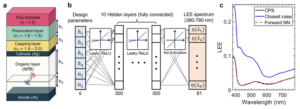
제목: Quantum amplitude-amplification operators
논문지, 연도: Physical Review A, 2021
저자: Hyeokjea Kwon and Joonwoo Bae
초록: In this work, we show the characterization of quantum iterations that would generally construct quantum amplitude-amplification algorithms with a quadratic speedup, namely, quantum amplitude-amplification operators (QAAOs). Exact quantum search algorithms that find a target with certainty and with a quadratic speedup can be composed of sequential applications of QAAOs: existing quantum amplitude-amplification algorithms thus turn out to be sequences of QAAOs. We show that an optimal and exact quantum amplitude-amplification algorithm corresponds to the Grover algorithm together with a single iteration of QAAO. We then realize three-qubit QAAOs with current quantum technologies via cloud-based quantum computing services, IBMQ and IonQ. Finally, our results show that the fixed-point quantum search algorithms known so far are not a sequence of QAAOs; for example, the amplitude of a target state may decrease during quantum iterations.
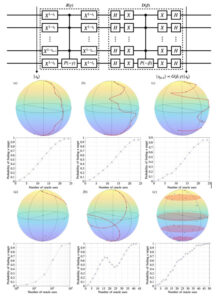
Title : Deep Reinforcement Learning-based Interconnection Design for 3D X-Point Array Structure Considering Signal Integrity
Abstract : In this paper, we, for the first time, proposed the Reinforcement Learning (RL) based interconnection design for 3D X-Point array structure considering crosstalk and IR drop. We applied the Markov Decision Process (MDP) to correspond to finding the optimal interconnection design problem to RL problem. We defined interconnection state to the vector, design to the action and the number of bits, crosstalk and IR drop are considered as the reward. The Proximal Policy Optimization (PPO) and Long Short-Term Memory (LSTM) are used to RL algorithms. The proposed interconnection design model is well trained and shows convergence of reward score in 16×16, 32×32 and 64×64 cases. We verified that the trained model finds out optimal interconnection design considering both memory size and signal integrity issues
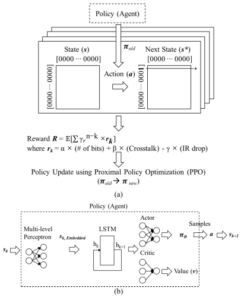
Title : Reinforcement-Learning-Based Signal Integrity Optimization and Analysis of a Scalable 3-D X-Point Array Structure
Abstract : In this article, we, for the first time, propose a reinforcement learning (RL) model to design an optimal 3-D cross-point (X-Point) array structure considering signal integrity issues. The interconnection design problem is modeled to the Markov decision process (MDP). The proposed RL model designs the 3-D X-Point array structure based on three reward factors: the number of bits, the crosstalk, and the IR drop. We applied multilayer perceptron (MLP) and long short-term memory (LSTM) to parameterize the policy. Proximal policy optimization (PPO) is used to optimize the parameters to train the policy. The reward of the proposed RL model is well-converged with variations in the array structure size and hyperparameters of the reward factors. We verified the scalability and sensitivity of the proposed RL model. With the optimal 3-D X-Point array structure design, we analyzed the reward factor and signal integrity issues. The optimal design of the 3-D X-Point array structure shows 17%–26.5% better signal integrity performance than the conventional design in finer process technology. In addition, we suggest a range of possible directions for improvement of the proposed model with variations in MDP tuples, reward factors, and learning algorithms, among other factors. Using the proposed model, we can easily design an optimal 3-D X-Point array structure with a certain size, performance capabilities, and specifications based on reward factors and hyperparameters.

Conference : DesignCon 2022
Title : Learning Super-scale Microbump Pin Assignment Optimization for Real-world PCB Design with Graph Representation
Authors: Joonsang Park, Minsu Kim, Seonguk Choi, Jihun Kim, Haeyeon Kim, Hyunwook Park, Seongguk Kim, Taein Shin, Joungho Kim
Abstract: The requirement for higher bandwidth in computing systems has increased. Hence, the number of I/Os of 2.5D/3D ICs is also increasing for dense interconnections. Accordingly, the pin count of the microbump package is getting larger along with its signal integrity issues. In this paper, we propose a deep reinforcement learning (DRL)-based pin assignment optimization method that represents microbumps on graphs to minimize signal integrity degradation. The pin assignment task of microbumps is formulated by modifying the maximum independent set (MIS) problem which is a graph combinatorial optimization task. The proposed method is designed by making adjustments to a state-of-the-art DRL-based MIS solver. The graph-based learning method brings advantages in that it can assign pins to pin maps of any shape on a very large scale. We verify that the proposed DRL-based method is effective by comparing it with a meta-heuristic method, a conventional method for solving optimization tasks, called genetic algorithm.

Conference : EPEPS 2021
Title: Deep Reinforcement learning-based Pin Assignment Optimization of BGA Packages considering Signal Integrity with Graph Representation
Authors: Joonsang Park, Minsu Kim, Seongguk Kim, Keeyoung Son, Taein Shin, Hyunwook Park, Jihun Kim, Seonguk Choi, Haeyeon Kim, Keunwoo Kim, and Joungho Kim
Abstract: In this paper, we propose a novel deep reinforcement learning (DRL)-based pin assignment method by representing ball grid array (BGA) packages on graphs to minimize signal integrity issues. The proposed method represents the pin arrangement of BGAs in graphs to formulate the pin assignment task to a variant of the maximum independent set (MIS). Then, a state-of-the-art DRL-based MIS solver was introduced to solve our task. Unlike previous methods of BGA optimization, the proposed graph representation of pins makes it possible to assign pins of any shape. Moreover, the significant scaling performance enables us to handle BGA with high pin count. We verify that the proposed DRL-based method with graph representation is effective by comparing it with conventional meta-heuristic methods including genetic algorithm (GA).
